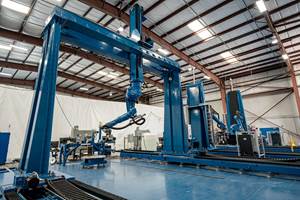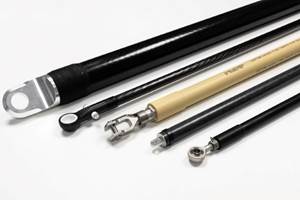One challenge to kitting prepreg fabrics or unidirectional (UD) tapes is figuring out what to do with trimmings that are too small or whose fibers are incorrectly aligned for reuse in another project. Although nesting software and cutters have reduced scrap significantly, trimmings still often go into a landfill, which adds to material and part costs as well as environmental burden. However, a Dutch company, Van Wees UD and Crossply Technology BV (Tilburg, Netherlands), is helping improve sustainability by developing a new technology — and the machines that make it possible — to reuse thermoplastic tape offal.
Textile roots
Founded in 1945 and with deep roots in the textile industry, Van Wees is a full-service provider that designs, produces, installs and commissions machines and production lines to produce advanced composites (thermoset or thermoplastic, carbon or glass fiber) with a focus on high-quality, high-volume production methods. The company makes prepreg impregnation lines (including creels) — primarily for epoxies on the thermoset side and for materials ranging from polypropylene (PP) to high-temperature polyamides (PAs) on the thermoplastic side — as well as crossply and multiaxial UD tape placement machines, which can process either thermoplastic or thermoset tapes. A sister company, Eltra Engineering BV (also in Tilburg) specializes in industrial automation technology and supplies electrical controls and software for Van Wees machines.
At its Research and Technology Center (R&TC), Van Wees maintains production-scale equipment for its own process development as well as for customers considering a Van Wees system, or who are learning to operate equipment while waiting for their machines to be built. This allows customers to produce material that they can evaluate or, in turn, offer to their own customers for evaluation. For example, at the R&TC, tows can be pulled from a creel and fibers spread and impregnated to produce tapes, which then can be fed through the company’s crossply or multiaxial UD machines to produce laminates with a variety of ply layers and fiber orientations. (Crossply laminates have at least two plies oriented at 0/90 degrees and multiaxial UD laminates have at least two UD plies oriented at angles other than 0/90 degrees.) Laminates exiting these machines are tacked together for ease of handling. They may next be die-cut into net-shape preforms that are then ready for processing into a composite part. Although Van Wees’ equipment focus with the crossply and multiaxial UD equipment is on production of UD thermoplastic tapes, the machines can be used to produce tapes with thermoset matrices and/or with fabric rather than UD reinforcements.
Interestingly, it was Van Wees’ own scrap problem from making these products for customer testing, as well as customer requests, that led company researchers to develop a “zero-waste process” to recycle chips/offal from preform production using tailored-fiber blanks. As a service, the company is offering customers the opportunity to evaluate these chip-based thermoplastic blanks and already has developed equipment to commercially produce them at high production volumes.
Waste not, want not
During die-cutting operations to make net-shaped preforms (which Van Wees calls “patches”), scrap material is collected and segregated by resin and fiber type. This scrap is irregularly shaped and sized, so die cutters are designed to produce “chips” with a maximum size of 50 by 50 millimeters. Chopped chips are then pressed into a consolidated sheet (via compression or vacuum molding), resulting in a laminate with randomly oriented, discontinuous fibers. No additional resin is needed to make the sheet, and only chips with chemically compatible resins are mixed together, although both glass and carbon fiber-reinforced chips may be combined depending on properties desired in the final part that will be formed from the chips-based laminate.
Because fibers in individual chips within the laminate can be up to 50 millimeters long, and fiber orientation across the sheet is random, the 100 percent recycled, zero-waste tailored blanks provide good and orthotropic stiffness and strength — particularly compared with short-fiber injection molding compounds. However, since fiber weight fractions for the laminates’ discontinuous fiber bundles can run 50-70 percent — with initial formulations on the high end of that range — the material can barely flow in a compression press. Therefore, to fill 2.5D or 3D geometry, the chip-based laminate must be overmolded with short fiber or even neat resin in an injection molding machine. It also could be co-molded with a continuous-fiber material in a compression press. Either way, the laminate does need to be preheated prior to molding.
Interestingly, Van Wees has found that the chip-based panels still provide half the bending strength and modulus of its high-performance, continuous-fiber crossply panels in the same fiber and resin configuration.
Concept prove out
To showcase the capabilities of its zero-waste tailored blanks, Van Wees has conducted several demonstrator projects. One was a stiffening/crash beam for door inner panels on a passenger car. This effort was based on the Lipa Series project, which developed lightweight composite parts for series production for a range of industries. The now-inactive consortium based in Büsslingen, Switzerland, built on core technologies involving preforming continuous-fiber organosheet/glass-mat thermoplastic (GMT) composites and then back filling with fiber-reinforced resin in an injection molding machine.
Van Wees’ demonstrator beam (a part used to pass side impact/intrusion regulations) was approximately 650 millimeters long, 110 millimeters wide, had a nominal wall of 3 millimeters, and weighed roughly 450 grams in the benchmark material, which was a 3-millimeter glass fabric-reinforced PA6. The part also featured a domed structure in the center that was 40 millimeters high. The organosheet crash beam did not provide sufficient energy absorption to meet application requirements, so Van Wees researchers attempted to improve overall performance in the same wall thickness (since existing tooling was used), in a cycle time of less than one minute and with zero waste.
Working with several polymer suppliers, Van Wees produced UD tapes in-house using several polymers and reinforcements — including glass fiber/PA4/10, glass fiber/PP, carbon fiber/PP, and glass + carbon fiber/PP. Matching short-fiber injection overmolding compounds were produced by the resin suppliers. Simulation was used to evaluate the number and orientation of individual UD plies for tailored blanks in order to meet or exceed performance requirements. Next, tapes were used to produce continuous-fiber laminates, from which the crash beams were produced. Computer-aided engineering (CAE) results predicted the glass fiber/PA4/10 tailored blanks would provide the best properties at lower cost than the fabric/organosheet, and physical testing confirmed this.
To further explore opportunities to reduce waste and cost, researchers reused scrap (approximately 30 percent cutting losses) generated from producing continuous fiber laminates to produce crash beams, recycled that material into chip-based laminates that were 1-millimeter thick, and used that product as a core layer (replacing three UD plies) between “skins” of more UD material made on the multiaxial UD machine. Interestingly, in preliminary tests with a limited sample size, they saw little or no loss in performance for the hybrid laminates with a mix of continuous and discontinuous reinforcement compared to the full continuously reinforced laminates.
Additional calculations conducted by the team indicated that it would be possible to meet Van Wees’ production goals of 2 million crash beams per year, using the 1-minute composite overmolding process developed by the Lipa Series team. Given the speed at which the Van Wees tailored-blank production lines operate (1,800 patches/hour on the multiaxial UD machine and 1,260 patches/hour on the crossply machine), adding additional equipment to convert scrap into chips-based laminates would create a zero-waste production system and increase production volumes 30 percent to 2.6 million parts per year. Ironically, the injection molding machines would be the rate-limiting step in this production sequence — something that doesn’t often happen.
Another rapid-turnaround project that company researchers conducted was to develop composite-faced door handles for the conference room at Van Wees headquarters. Final composite inserts were available for attendees to view at last year’s Composites Overmolding conference.
“Co-development and innovation are the driving forces of modern industry,” notes Rien van den Aker, Van Wees director. “We believe that joint development with all the players in the composite chain is of prime interest. Metals are the competitors of our industry and are made in the most rational way. Therefore, it will only be with intelligent processes and equipment that we can introduce lightweight composite products into high-volume applications.” He emphasizes that it will take a joint effort among supply chain members to make zero-waste production of thermoset and thermoplastic composite parts possible. “Van Wees is happy to assist interested parties with product and process development,” he adds.
Related Content
Innovation in ultrasonic inspection and nondestructive testing
With increasingly complex structural components working their way into aerospace programs, the need for versatility in inspection and testing capabilities is growing.
Read MoreNovel processes for hybrid thermoset-thermoplastic pultruded parts
CFRP pultrusion and pullwinding specialist Epsilon Composite combines thermoplastic overmolding with traditional thermoset processes, demonstrated through aircraft struts and industrial applications.
Read MoreThe potential for thermoplastic composite nacelles
Collins Aerospace draws on global team, decades of experience to demonstrate large, curved AFP and welded structures for the next generation of aircraft.
Read MoreInfinite Composites: Type V tanks for space, hydrogen, automotive and more
After a decade of proving its linerless, weight-saving composite tanks with NASA and more than 30 aerospace companies, this CryoSphere pioneer is scaling for growth in commercial space and sustainable transportation on Earth.
Read MoreRead Next
“Structured air” TPS safeguards composite structures
Powered by an 85% air/15% pure polyimide aerogel, Blueshift’s novel material system protects structures during transient thermal events from -200°C to beyond 2400°C for rockets, battery boxes and more.
Read MoreVIDEO: High-volume processing for fiberglass components
Cannon Ergos, a company specializing in high-ton presses and equipment for composites fabrication and plastics processing, displayed automotive and industrial components at CAMX 2024.
Read MoreAll-recycled, needle-punched nonwoven CFRP slashes carbon footprint of Formula 2 seat
Dallara and Tenowo collaborate to produce a race-ready Formula 2 seat using recycled carbon fiber, reducing CO2 emissions by 97.5% compared to virgin materials.
Read More

.jpg;width=70;height=70;mode=crop)





















